You'll enjoy a remarkable audio experience when you get the best speakers for your setup. Once you learn more about the available options, you can pick the right speakers for your home.

Speaker Buying Guide.
Initial considerations.
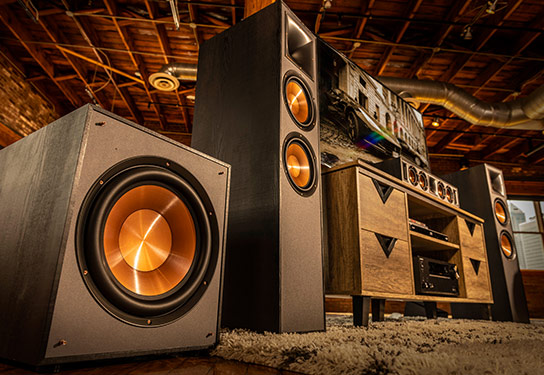
Before you even start researching speaker features, evaluate the room where you'll place the speakers. A variety of factors in a room can affect the type of speakers you'll want to choose.
Create a setup to suit your entertainment
Speaker configurations are uniquely suited to the type of audio you'll listen to. If you're interested in how your music collection sounds, you'll want to purchase quality left and right stereo speakers. For movies, you can expand your setup by creating a surround sound environment with a receiver and additional speakers that offer an immersive home theater experience.
What else is in the room?
The space you'll place your speakers will affect the sound quality. Hard surfaces like windows and wood floors will reverberate sound, which can distort the audio by amplifying your speaker power or canceling out the sound. Softer surfaces like drapes and carpeting can absorb sound, and irregular surfaces like bookcases will diffuse (spread out) sound.
Portable speakers offer you placement flexibility, so you can enjoy music in any room, while traveling or at an outdoor party. Some portable speakers also feature a rechargeable battery, so you don't need to be near an outlet to listen, making it even easier to take your music on-the-go.
Trust your ears
Each person appreciates a different part of the audio experience. Have you ever had a friend adjust your car audio settings and you can't understand what's wrong with him? The same is true with your home speaker setup. Take some time to understand what it is that you appreciate: smooth sound, bright tones, heavy bass? Visit your local Best Buy store to experience a few models and then use that knowledge when shopping in store and online.
Magnolia®
With Magnolia, you can experience some of the most-sought-after brands in the audio industry, including Definitive Technology, Bowers & Wilkins and MartinLogan. These are the premium brands that true audiophiles crave, because once you experience these speakers and other home audio products, you'll accept nothing less.

Individual speaker types.
Individual speaker components offer you the ability to create your own custom soundscape.
Floor speakers
By providing the front left and right sound, floor speakers deliver the majority of sound effects, offering a more realistic experience when watching TVs and movies. They also provide stereo sound when listening to music. If you have a larger TV, floor speakers will pair well with your TV style and size.
Bookshelf speakers
Bookshelf speakers are a great place to start when building your setup. Similar to floor speakers, bookshelf speakers usually offer less bass response, while the compact size allows you to fit them in smaller spaces. Placing the speakers on stands will provide the best audio quality, since the added height aims the sound directly at your ear. You can also use these speakers as rear speakers for a surround sound environment.
Shop for:
Subwoofers
Delivering the bass that makes TV show and movie sound effects feel realistic, subwoofers also provide a level of bass that enriches music. You can place a subwoofer almost anywhere in the room, but experiment with location to find the sound you prefer. The closer you place a subwoofer to a corner, the more bass it will reproduce.
Center-channel speakers
Just as the name implies, this speaker is placed in a central spot below your TV. Since most dialogue is reproduced in the mid-range frequencies, you'll want to be able to hear the dialogue over all the sound effects.
Surround speakers
You can expand your setup with speakers placed behind your listening space and at the sides. Surround speakers deliver even more ambient sounds, creating an immersive experience you'll love when playing video games and watching movies.
Dolby Atmos-enabled speakers
Create a multidimensional experience with speakers that direct sound upward where it reflects off the ceiling for incredible realism. Choose from add-on modules and integrated units with front-firing speakers.
Additional components.
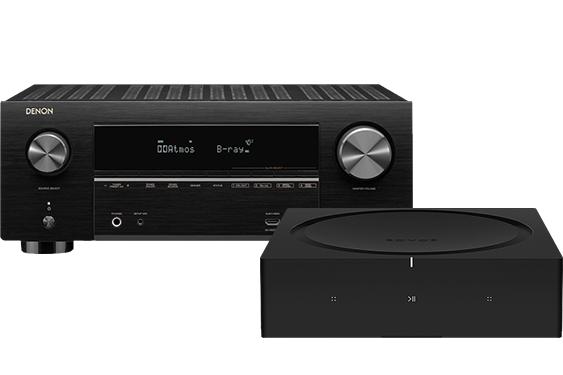
Receivers and amplifiers
For true surround sound for both TV and music, an A/V home theater receiver is an essential addition to your speakers. It acts as the hub of your home theater. An A/V receiver takes in content from your TV and other audio players, amplifies the sound, and then disperses it to various speakers, or channels. It lets you experience the fine details of the original content, which you won't get from your TV speakers or a sound bar.
When choosing a receiver, take a close look at inputs, channels and wattage. The receiver should have enough inputs for all the devices you have now — TV, cable box, Blu-ray player, etc. — plus room for a future device or two. Be sure it has 4K Ultra HD pass-through technology for use with a 4K TV. You also need a receiver with enough channels. Think of channels as speakers. With more channels, you can have more speakers, which leads to more immersive sound. For example, a 2-channel receiver, also known as a stereo receiver, supports two speakers and is for listening to music only. A 5.1-channel receiver supports two front speakers, a center-channel speaker, subwoofer and two rear speakers, giving you surround sound. Lastly, the greater the wattage on the receiver, the more efficiently it can power various speakers. Some receivers have an output jack for adding an amplifier to boost the power.
Beyond the basics, receivers offer a wide range of specialty features, including built-in Wi-Fi for music streaming, multiroom audio support and compatibility with Amazon Alexa or Google Assistant for voice control.
Speaker accessories
You'll likely need a few extras while creating your home audio setup. Check out our large selection of accessories, from audio cables and speaker wire to speaker mounts and stands.

Complete systems and special-purpose speakers.
Offering a total soundscape in one package, complete systems are the easy way to amplify your audio experience with just one purchase. Today's options include portable speakers for on-the-go convenience, wireless speakers for flexible placement and more.
Packaged surround systems
If you already own a receiver and don't want to bother comparing individual speaker components, a speaker system might be a good option for you. These packaged systems come in a variety of configurations and price ranges. True surround sound is delivered from a 5.1 system, which includes the left speaker, right speaker, subwoofer, and two rear-channel or "surround" speakers. You can also choose a home-theater-in-a-box which includes the receiver.
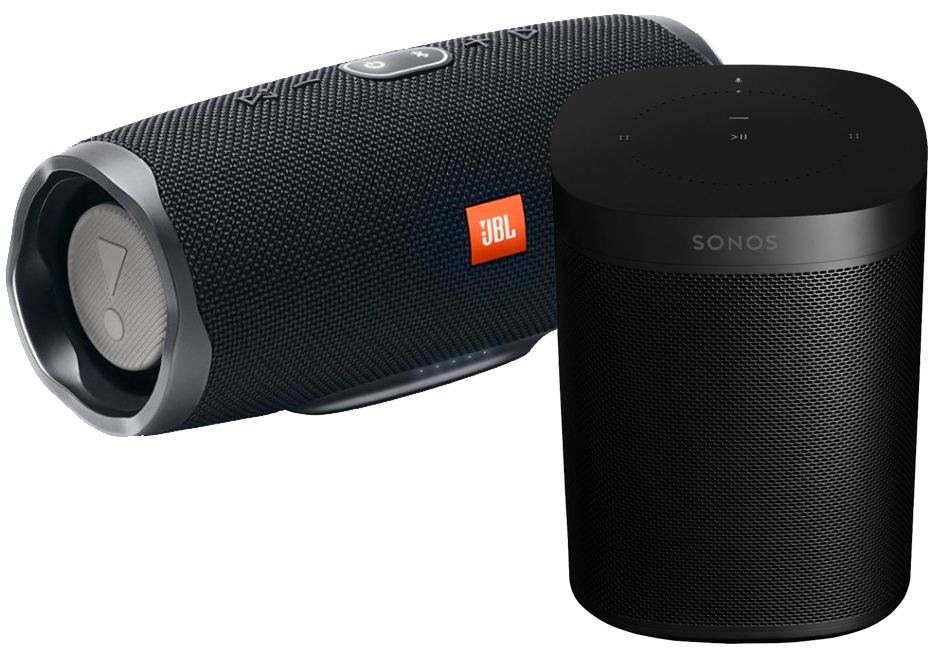
Portable and wireless speakers
A portable speaker gives you the ultimate music-on-the-go experience, since it can fit into everything from your suitcase to the palm of your hand. These lightweight speakers are an easy way to add ambiance to any event. Choose a water-resistant model for pool parties, camping and other outdoor gatherings.
Offering flexibility and convenience, wireless speakers use technology like Bluetooth, AirPlay or Wi-Fi to receive an audio signal from a compatible device. Many wireless speakers are compact, making it easy to place in any room of your house. Certain systems are expandable, so you can always add a new speaker or two as needed. Just plug in the speaker, and easily control your music using a smartphone or tablet, play different audio over each speaker, or hear the same song everywhere.
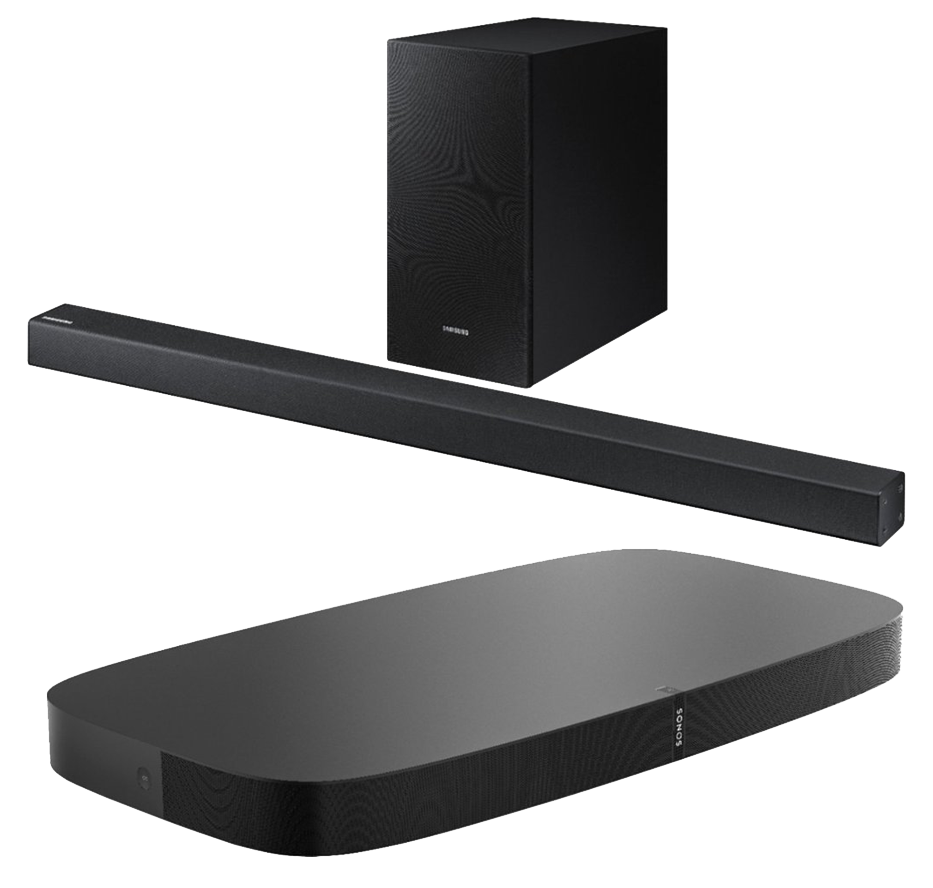
Sound bars and sound bases
A sound bar offers a simple way to improve the audio experience delivered from your TV speakers. Offering big cinematic sound without taking up a lot of space, there are fewer wires to deal with than with a complete surround sound system. Most sound bars are ideally suited to a smaller symmetrical room that allows the sound to reflect off the walls.
You can also find sound bars packaged with a wireless subwoofer to deliver additional bass. Just place the subwoofer wherever you can plug it in, even under a table or couch.
Similar to a sound bar, a sound base is designed to fit under a smaller TV, delivering big cinematic audio, without taking up a lot of space.
Some sound bars and sound bases use technology like Bluetooth, AirPlay or Wi-Fi to receive an audio signal from a compatible device.

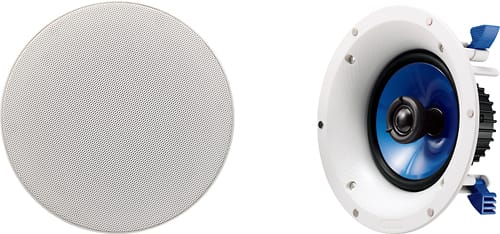
Architectural speakers
Designed to blend into the surroundings with paintable flanges and grills, in-wall and in-ceiling speakers can provide the surround sound experience you want, without interfering with your decor. Requiring installation, these speakers also eliminate visible wires.
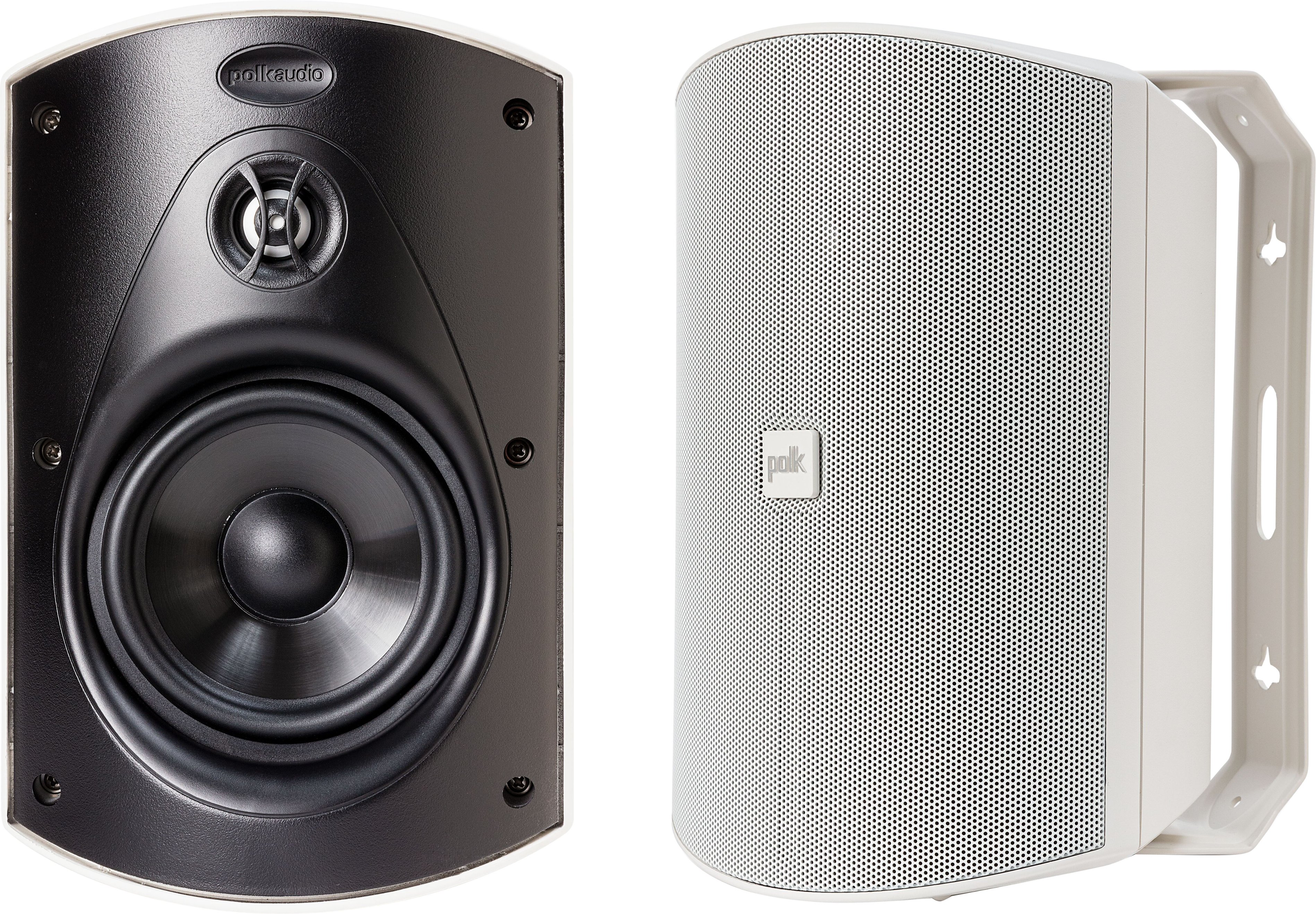
Outdoor speakers
Enhance your time lounging on the patio or liven up backyard parties with outdoor speakers. Wired speakers provide high-quality sound, feature a weather-resistant design and can be installed in various locations. Some outdoor speakers, available in wired and wireless models, even look like rocks to blend into your landscape. Or take your music beyond the backyard with portable wireless speakers that offer a rugged — and sometimes waterproof — design for outdoor adventures.
Understanding speaker specs.
Once you know what type of speakers you want to buy, learning more about the specifications can help you comparison shop.
Frequency response
Measured in Hertz, the frequency response refers to the frequency range that a speaker can reproduce. A speaker, when provided an audio signal at a given level and a given frequency, will produce a certain amount of loudness. Ideally, if you keep the level the same, but change the frequency, the loudness would remain the same. That would be called a flat frequency response.
The average human ear can detect a maximum frequency range of 20Hz to 20KHz, so look for a speaker that can reproduce as much of that range as possible. Keep in mind that there is no standard on how this is measured, so you'll want to take into account other features when comparing speakers.
Impedance
Measured in ohms, impedance describes how much electrical resistance an amplifier will encounter when trying to drive a given speaker. Most speakers are designed with 8-ohm impedance, which will work fine with almost any home audio equipment. For consistent response, all speakers should have the same impedance; so when replacing a single speaker, ensure it matches the rest of your setup.
Sensitivity
Measured in decibels per watt, sensitivity refers to how loud a speaker can deliver audio per watt of power. The higher the sensitivity, the less power the speaker needs to achieve a high volume. Low sensitivity is around 88 decibels per watt, while high sensitivity is100 decibels per watt.
Power handling
Measured in watts, power handling capacity indicates the maximum sound signal that a speaker can accept. Feeding a speaker more power than it can handle can damage the speaker, but many speakers with high power handling capacities actually require a more powerful amplifier to sound their best. For best results, choose speakers that can handle approximately the maximum output of your receiver. Keep in mind that there is no standard on how this is measured, so you'll want to take into account other features when comparing speakers.
Shop online or in store.

Find a wide variety of speakers on BestBuy.com. Your local Best Buy store also has a selection of speakers, many of which are available to compare and test out. Plus, our friendly Blue Shirts are there to answer questions and help with choosing the best speakers for your needs.